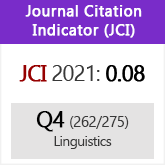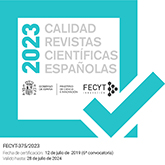Paradigmaticity effects in Spanish verb stress
DOI:
https://doi.org/10.3989/loquens.2017.045Keywords:
perceptual variety linguistics, mental representations, perceptual phonetics, salience, Andalusian dialectologyAbstract
Although much of what has been written on Spanish verb stress shares the intuition that it depends on the interaction of phonological and morphological factors, its study is hindered by the fact that it is focused from an exclusively morphosyntactic or phonological point of view in some cases whereas in others relevance is given only to morphological structure. This paper places the interaction of phonology and morphology in the center of the reflection on Spanish verb stress. After briefly examining the correlation that exists between so-called inflectional segments and lexical stress, we review the most relevant analyses concerning Spanish verb stress from a morphosyntactic and morphological point of view. We suggest that one of the most serious flaws of the former has to do with the fact that they lose sight of the more characteristic specificity of verbal forms, namely that they are part of subparadigms that have stress uniformity as one of their essential features. On the other hand, morphological analyses tend to be based on the idea of a strict symmetry between temporal and accentual subparadigms, and, therefore, to propose morphological explanations, which, however, do not seem to be consistent with the stress patterns typical of present forms and so-called strong preterites. We aim to show that the interest of the notion of subparadigm manifests itself most clearly in an analysis that takes into account the phonological and morphological factors associated with stress regularity and markedness, besides distinguishing morphological and accentual subparadigms. We also suggest that the effects of these factors are best examined on the basis of the subsets (temporal, tempomodal subparadigms) that make up the verbal system, i.e., taking into account the characteristics of the forms included in each subset as well as the relationships in which they are involved. From this point of view, the accentual profile of each subparadigm depends on the interaction of strictly prosodic requirements with morphological factors such as morphoprosodic leveling, lexical stress, and what we will call subparadigmatic or positional stress. Whereas the effects of this interaction have a more or less local range, the factors involved in it determine the paradigmaticity effects observed in Spanish conjugation and, ultimately, the degree of morphologization of verb stress in Spanish
Downloads
References
Alcoba, S. (1991). Verb stress in Spanish. En Actes du XIIème Congrès International des Sciences Phonétiques (pp. 202-205). Service de Publications de l'Université de Provence.
Alcoba, S. (1992). ¿Consideración no diacrónica de la morfología y acento del tema de futuro? En J. A. Bartol Hernández, J. de Santiago Guervós y J. F. García Santos (Eds.), Estudios filológicos en homenaje a Eugenio de Bustos Tovar, 1 (pp. 35-50). Salamanca: Ediciones de la Universidad de Salamanca.
Alcoba, S. (1999). La flexión verbal. En I. Bosque y V. Demonte (Dirs.), Gramática descriptiva de la lengua española, 3 (pp. 4915-4992). Madrid: Espasa Calpe.
Alcoba, S. (2013). Cambios de acento en español. Verba, 40, 415-452.
Alvar, M., y Pottier, B. (1983). Morfología histórica del español. Madrid: Gredos.
Ambadiang, T. (2016a). Flexión verbal. En J. Gutiérrez-Rexach (Ed.), Enciclopedia de lingü.stica hispánica, 2 (pp. 584-594). Londres: Routledge.
Ambadiang, T. (2016b). Variabilidad en la estructura morfológica de los sustantivos españoles. Anuario de Letras. Lingüistica y Filología, 4(2), 5-58.
Ambadiang, T., Camus Bergareche, B., y García Parejo, I. (2008). Representación, procesamiento y uso en la morfología del verbo español. Verba, 35, 7-34.
Bakovic, E. (2016). Exceptionality in Spanish stress. Catalan Journal of Linguistics, 15, 9-25. https://doi.org/10.5565/rev/ catjl.182
Bello, A. (1981). Gramática de la lengua castellana (ed. crítica de R. Trujillo). Tenerife: Cabildo Insular de Tenerife.
Bobaljik, J. D. (2008). Paradigms (optimal and otherwise): A case for skepticism. En A. Bachrach y A. Nevins (Eds.), Inflectional identity (pp. 29-54). Oxford: Oxford University Press.
Boyé, G., y Schalchli, G. (2016). The status of paradigms. En A. Hippisley y G. Stump (Eds.), The Cambridge handbook of morphology (pp. 206-234). Cambridge: Cambridge University Press. https://doi.org/10.1017/9781139814720.009
Bybee, J. L. (1985). Morphology: A study of the relation between meaning and form. Ámsterdam: John Benjamins. https://doi.org/10.1075/tsl.9
Clahsen, H., Aveledo, F., y Roca, I. (2002). The development of regular and irregular verb inflection in Spanish child language. Journal of Child Language, 29(3), 591-622. https://doi.org/10.1017/S0305000902005172 PMid:12109365
Delattre, P. (1965). Comparing the phonetic features of English, German, Spanish and French. Heidelberg: Julius Groos.
Doner, J. M. (2013). The unification of Spanish verbal and non-verbal stress. Toronto Working Papers in Linguistics.
Dunlap, E. R. (1991). Issues in the moraic structure of Spanish [tesis doctoral]. University of Massachusetts at Amherst.
Embick, D. (2015). The morpheme: A theoretical introduction. Berlín: De Gruyter Mouton. https://doi.org/10.1515/9781501502569
Harris, J. W. (1983). Syllable structure and stress in Spanish: A nonlinear analysis. Cambridge, MA: The MIT Press.
Harris, J. W. (1987). The accentual patterns of verb paradigms. Natural Language and Linguistic Theory, 5(1), 61-90. https://doi.org/10.1007/BF00161868
Harris, J. W. (1989). How different is verb stress in Spanish. Probus, 1(3), 241-258. https://doi.org/10.1515/prbs.1989.1.3.241
Harris, J. W. (1991). The exponence of gender in Spanish. Linguistic Inquiry, 22(1), 27-62.
Harris, J. W. (1992a). The form classes of Spanish substantives. En G. Booij y J. van Marle (Eds.), Yearbook of morphology 1991 (pp. 65-88). Dordrecht: Kluwer. https://doi.org/10.1007/978-94-011-2516-1_6
Harris, J. W. (1992b). Spanish stress: The extrametricality issue. Bloomington: Indiana University Linguistics Club.
Harris, J. W. (1995). Projection and edge marking in the computation of stress in Spanish. En J. A. Goldsmith (Ed.), The handbook of phonological theory (pp 867-887). Cambridge, MA/ Oxford: Blackwell.
Hooper, J. B., y Terrell, T. (1976). Stress assignment in Spanish: A natural generative analysis. Glossa, 10(1), 64-110.
Hualde, J. I. (2012). Stress and rhythm. En J. I. Hualde, A. Olarrea y E. O'Rourke (Eds.), The handbook of Hispanic linguistics (pp. 153-171). Chichester, West Sussex: Wiley Blackwell. https://doi.org/10.1002/9781118228098.ch8
Hualde, J. I. (2014). Los sonidos del español. Cambridge: Cambridge University Press. https://doi.org/10.1017/CBO9780511719943 https://doi.org/10.1017/CBO9780511719943
Hurch, B. (1996). Accentuations. En B. Hurch y R. A. Rhodes (Eds.), Natural phonology. The state of the art (pp. 73-96). Berlín: De Gruyter Mouton. https://doi.org/10.1515/9783110908992.73
Janda, R. (1993). Metrical phonology & the «columnar» morphology of Spanish verb-stress. En A. Crochetière, J.-C. Boulanger y C. Ouellon (Eds.), Proceedings of the 15th International Congress of Linguists, 1 (pp. 51-54). Sainte-Foy: Presses de l'Université de Laval.
Martínez-Paricio, V. (2012). Identity effects in Uruguayan Spanish. En E. Boone, M. Kohlberger y M. Schulpen (Eds.), Proceedings of ConSOLE, 20 (pp. 131-152).
McCarthy, J. J. (2005). Optimal paradigms. En L. J. Downing, T. A. Hall y R. Raffelsiefen. (Eds.), Paradigms in phonological theory (pp. 170-210). Oxford: Oxford University Press. PMid:15975362
Meinschaefer, J. (2011). Accentual patterns in Romance verb forms. En M. Maiden, J. C. Smith, M. Goldbach y M.-O. Hinzelin (Eds.), Morphological autonomy: Perspectives from Romance inflectional morphology (pp. 51-69). Oxford: Oxford University Press. https://doi.org/10.1093/acprof:oso/9780199589982.003.0004
Menéndez Pidal, R. (1982). Manual de gramática histórica española (17.ª ed.). Madrid: Espasa Calpe.
Ohannesian Saboundjian, M. (2004). La asignación del acento en castellano [tesis doctoral]. Universidad Autònoma de Barcelona. Disponible en http://hdl.handle.net/10803/4832
Ohannesian, M., y Pons, C. (2009). Shattering paradigms: An attempt to formalize pressures within paradigms. En F. Montermini, G. Boyé y J. Tseng (Eds.), Selected Proceedings of the 6th Décembrettes (pp. 76-94). Somerville, MA: Cascadilla Proceedings Project.
Oltra-Massuet, I. (1999). On the constituent structure of Catalan verbs. En K. Arregi, B. Bruening, C. Krause y V. Lin (Eds.), MIT Working Papers in Linguistics, 33. Papers on morphology and syntax. Cycle one (pp. 279-322). Cambridge, MA: MIT.
Oltra-Massuet, I., y Arregi, K. (2005). Stress-by-structure in Spanish. Linguistic Inquiry, 36(1), 43-84. https://doi.org/10.1162/0024389052993637
Pato, E. (2012). Cantabámos por cantábamos: forma 'etimológica' del español rural. Archivo de Filología Aragonesa, 68, 213-230.
Pi-eros, C.-E. (2016). Acento. En J. Gutiérrez-Rexach (Ed.), Enciclopedia de lingüistica hispánica, 2 (pp. 357-368). Londres: Routledge.
RAE/ASALE (2009). Nueva gramática de la lengua Española, 1 (cap. 4). Madrid: Espasa Calpe.
Rini, J. (1999). Exploring the role of morphology in the evolution of Spanish. Ámsterdam: John Benjamins. https://doi.org/10.1075/cilt.179
Roca, I. (1988). Theoretical implications of Spanish word stress. Linguistic Inquiry, 19(3), 393-423.
Roca, I. (1990). Morphology and verbal stress in Spanish. Probus, 2(3), 321-350. https://doi.org/10.1515/prbs.1990.2.3.321
Roca, I. (1992). On the sources of word prosody. Phonology, 9(2), 267-287. https://doi.org/10.1017/S0952675700001615
Roca, I. (2005). Saturation of parameter settings in Spanish stress. Phonology, 22(3), 345-394. https://doi.org/10.1017/S0952675705000655
Roca, I. (2006). The Spanish stress window. En F. Martínez-Gil y S. Colina (Eds.), Optimality. Theoretic studies in Spanish phonology (pp. 239-277). Filadelfia, PA: John Benjamins. PMid:16750108
Sanz-Sánchez, I. (2011). Analogical imperfects and the fate of Iberian verbal morphology. Southwest Journal of Linguistics, 30(2), 55-59.
Sanz-Sánchez, I. (2016). A diachronic perspective on Latin American Spanish verbal morphology: Reassessing the role of koineization. En E. Nú-ez Méndez (Ed.), Diachronic applications in Hispanic linguistics (pp. 239-281). Cambridge: Cambridge Scholars Publishing.
Stump, G. (2015). Inflectional paradigms: Content and form at the syntax–morphology interface. Cambridge: Cambridge University Press.
Stump, G. T. (2016). Paradigms at the interface of a lexeme's syntax and semantics with its inflectional morphology. En D. Siddiqi y H. Harley (Eds.), Morphological metatheory (pp. 27-58). Filadelfia, PA: John Benjamins. https://doi.org/10.1075/la.229.02stu
Stump, G., y Finkel, R. A. (2013). Morphological typology: From word to paradigm. Cambridge: Cambridge University Press. https://doi.org/10.1017/CBO9781139248860
Tiersma, P. M. (1982). Local and general markedness. Language, 58(4), 832-849. https://doi.org/10.2307/413959
Published
How to Cite
Issue
Section
License
Copyright (c) 2018 Consejo Superior de Investigaciones Científicas (CSIC)

This work is licensed under a Creative Commons Attribution 4.0 International License.
© CSIC. Manuscripts published in both the printed and online versions of this Journal are the property of Consejo Superior de Investigaciones Científicas, and quoting this source is a requirement for any partial or full reproduction.All contents of this electronic edition, except where otherwise noted, are distributed under a “Creative Commons Attribution 4.0 International” (CC BY 4.0) License. You may read here the basic information and the legal text of the license. The indication of the CC BY 4.0 License must be expressly stated in this way when necessary.
Self-archiving in repositories, personal webpages or similar, of any version other than the published by the Editor, is not allowed.















